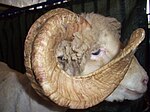Howard Lodge
African-American history of Howard County, MarylandBaltimore metropolitan area Registered Historic Place stubsGeorgian architecture in MarylandHouses completed in 1750Houses in Howard County, Maryland ... and 7 more
Houses on the National Register of Historic Places in MarylandHoward County, Maryland geography stubsHoward County, Maryland landmarksNational Register of Historic Places in Howard County, MarylandPlantation houses in MarylandPlantations in MarylandSykesville, Maryland

Howard Lodge is a historic plantation house in north-central Howard County, Maryland. The main house, built around 1750 by Edward Dorsey, son of John Dorsey, is one of the oldest plantation houses in the county. Compared to other houses of the period, the two-story brick and stone structure is larger and its interior finishes better preserved. The surviving plantation property, about 15 acres (6.1 ha), also includes early 19th-century stone outbuildings. Edward Dorsey was given ownership of seven African-American slaves by his father John Dorsey.The property was listed on the National Register of Historic Places in 2012.
Excerpt from the Wikipedia article Howard Lodge (License: CC BY-SA 3.0, Authors, Images).Howard Lodge
Luke Lane,
Geographical coordinates (GPS) Address Nearby Places Show on map
Geographical coordinates (GPS)
| Latitude | Longitude |
|---|---|
| N 39.337222222222 ° | E -76.939722222222 ° |
Address
Luke Lane
Luke Lane
21104
Maryland, United States
Open on Google Maps





